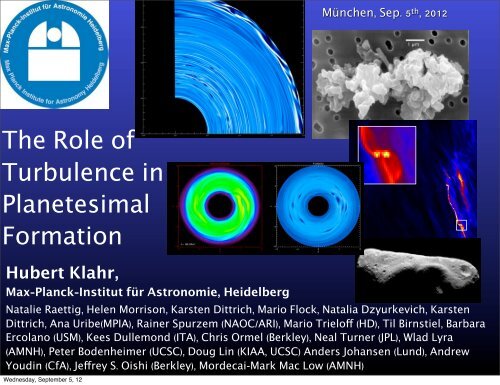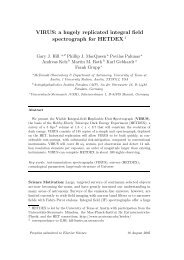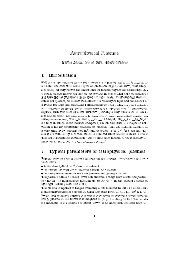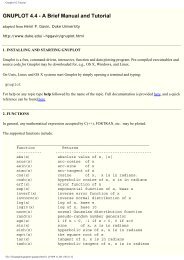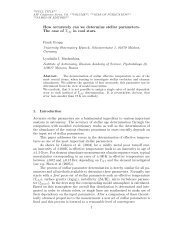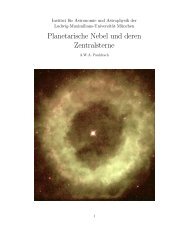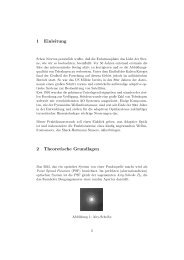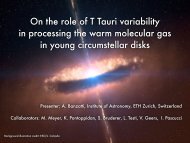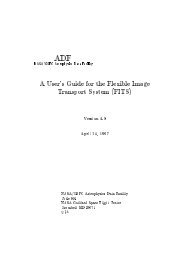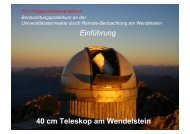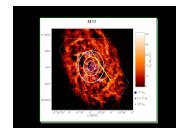pdf 3.6 MB
pdf 3.6 MB
pdf 3.6 MB
You also want an ePaper? Increase the reach of your titles
YUMPU automatically turns print PDFs into web optimized ePapers that Google loves.
The Role of<br />
Turbulence in<br />
Planetesimal<br />
Formation<br />
Hubert Klahr,<br />
200<br />
100<br />
500<br />
400<br />
300<br />
200<br />
100<br />
0<br />
0 100 200 300 400 500<br />
0<br />
t=36.1<br />
München, Sep. 5 th, 2012<br />
0<br />
0 100 200 300 400<br />
Max-Planck-Institut für Astronomie, 0 100 200Heidelberg 300 400 500<br />
t=36.3<br />
t=36.5<br />
Natalie Raettig, Helen Morrison, Karsten Dittrich, Mario Flock, Natalia Dzyurkevich, Karsten<br />
500<br />
500<br />
Dittrich, Ana Uribe(MPIA), Rainer Spurzem (NAOC/ARI), Mario Trieloff (HD), Til Birnstiel, Barbara<br />
Ercolano (USM), Kees Dullemond (ITA), Chris Ormel (Berkley), Neal Turner (JPL), Wlad Lyra<br />
(AMNH), 12/13/2009 400<br />
Peter Bodenheimer (UCSC), Hubert Doug Klahr Lin - Planet (KIAA, Formation UCSC) - MPIA 400<br />
Anders Johansen (Lund), 1 Andrew<br />
Heidelberg<br />
Youdin (CfA), Jeffrey S. Oishi (Berkley), Mordecai-Mark Mac Low (AMNH)<br />
Wednesday, September 5, 12<br />
300<br />
200<br />
100<br />
500<br />
400<br />
300<br />
200<br />
100<br />
300<br />
t=36.2<br />
0<br />
0 100 200 300 400
Outline:<br />
• Capturing Dust in Pressure maxima e.g.<br />
Zonal flows and vortices<br />
• MHD turbulence and Gravoturbulent<br />
Planetesimal formation -> Karsten Dittrich<br />
• Turbulence and vortices in Baroclinic<br />
disks: Disk Weather<br />
• Modified Symmetric Instability<br />
• Dust capturing in 3D vortices<br />
• Summary, Conclusions<br />
12/13/2009 Hubert Klahr - Planet Formation - MPIA<br />
Heidelberg<br />
Wednesday, September 5, 12<br />
The role of<br />
Turbulence in<br />
Planet Formation
Turbulence in a non rotating frame:<br />
Cuzzi et al.<br />
12/13/2009 Hubert Klahr - Planet Formation - MPIA<br />
Heidelberg<br />
Wednesday, September 5, 12<br />
L<br />
H<br />
Laboratory Conditions<br />
Dust collects between<br />
vortices (high pressure)
Particle response in rotating (DISK) frame:<br />
Geostophic flow: balance of pressure and Coriolis forces<br />
VORTICES:<br />
Barge & Sommeria 1995 ZONAL FLOWS:<br />
12/13/2009 Hubert Klahr - Planet Formation - MPIA<br />
Heidelberg<br />
Wednesday, September 5, 12<br />
H<br />
L<br />
H<br />
Radial Pressure maxima<br />
Klahr & Lin 2000
V<br />
e<br />
r<br />
t<br />
i<br />
c<br />
a<br />
l<br />
From dust/gas eq. 1 => Streaming Instability -<br />
> dust densities larger than local Roche<br />
density, e.g. Planetesimals can form.<br />
h o r i z o n t a l<br />
12/13/2009 Hubert Klahr - Planet Formation - MPIA<br />
Heidelberg<br />
Wednesday, September 5, 12<br />
Johansen, Henning & Klahr 2006
V<br />
e<br />
r<br />
t<br />
i<br />
c<br />
a<br />
l<br />
From dust/gas eq. 1 => Streaming Instability -<br />
> dust densities larger than local Roche<br />
density, e.g. Planetesimals can form.<br />
h o r i z o n t a l<br />
12/13/2009 Hubert Klahr - Planet Formation - MPIA<br />
Heidelberg<br />
Wednesday, September 5, 12<br />
Johansen, Henning & Klahr 2006
Disk:<br />
12/13/2009 Hubert Klahr - Planet Formation - MPIA<br />
Heidelberg<br />
Wednesday, September 5, 12<br />
…because it is a reliable source for turbulence.<br />
Box:<br />
6
MHD plus self-gravity for the dust, including particle feed back<br />
on the gas:<br />
gas<br />
dust<br />
Poisson equation solved via FFT in parallel mode: up to 256 3 cells<br />
12/13/2009 Hubert Klahr - Planet Formation - MPIA<br />
Heidelberg<br />
Wednesday, September 5, 12
Formation Of<br />
Planetesimals<br />
From pressure<br />
trapped /<br />
gravitational<br />
Bound heaps of<br />
gravel - here<br />
magnetic<br />
turbulence:<br />
Johansen, Klahr &<br />
Henning 2011.<br />
Next: Raettig &<br />
Lyra<br />
512 ^2 simulation<br />
64 Mio particles<br />
Entire project<br />
used 15 Mio. CPU<br />
hours.<br />
12/13/2009 Hubert Klahr - Planet Formation - MPIA<br />
Heidelberg<br />
Wednesday, September 5, 12<br />
Concentration in Zonal Flows:<br />
8
Wednesday, September 5, 12<br />
At 5123 100 and the usual set 100 up: As before mass of<br />
planetesimals 0 depends on 0 the available mass.<br />
500<br />
400<br />
300<br />
200<br />
100<br />
500<br />
400<br />
300<br />
200<br />
100<br />
0 100 200 300 400 500<br />
t=36.1<br />
0<br />
0 100 200 300 400 500<br />
t=36.3<br />
0<br />
0 100 200 300 400 500<br />
0 100 200 300 400 500<br />
t=36.2<br />
0<br />
0 100 200 300 400 500<br />
new: Intermediate Formation of Binaries;<br />
Johansen, Klahr & Henning (2011)<br />
500<br />
400<br />
300<br />
200<br />
100<br />
500<br />
400<br />
300<br />
200<br />
100<br />
t=36.5<br />
0<br />
0 100 200 300 400 500<br />
Fig. 6. The particle column density as a function of time after self-gravity is turned on after t = 35.0Torb. Theinsertshowsanenlargementofthe<br />
region around the point of highest column density.
Not the process but numerical resolution limit the smallest<br />
possible planetesimals. Johansen, Klahr & Henning 2011<br />
To predict an initial mass distribution of<br />
Planetesimals one needs A: the proper size<br />
distribution of precursors and B: the likely hood<br />
12/13/2009 for concentrations Hubert as Klahr a - Planet function Formation - MPIA of particle size. 10<br />
Heidelberg<br />
Wednesday, September 5, 12
Wednesday, September 5, 12<br />
Larger Boxes = better concentration<br />
Dittrich, Klahr & Johansen submitted<br />
See Talk by Karsten Dittrich
Natalia Dziurkevich (in prep.) see her POSTER!<br />
Active (Blue) and Dead (Yellow/Orange) Zones<br />
12/13/2009 => Planetesimals Hubert are Klahr - needed Planet Formation in - MPIA the Dead Zone. 12<br />
Heidelberg<br />
Wednesday, September 5, 12
12/13/2009 Hubert Klahr - Planet Formation - MPIA<br />
Heidelberg<br />
Wednesday, September 5, 12<br />
Baroclinic Effects on Earth:<br />
Formation of Hurricanes<br />
13
12/13/2009 Hubert Klahr - Planet Formation - MPIA<br />
Heidelberg<br />
Wednesday, September 5, 12<br />
Geophysical Baroclinic Instability<br />
14
�[g/cm 2 ]<br />
Klahr & Raettig in prep.<br />
Using data from Sean Andrews<br />
alpha = 0.001; Mdot = 1E-7 Msol/yr;<br />
Plus irradiation: Tstar = 4300; Rstar = 2 Rsol<br />
10 5<br />
10 4<br />
10 3<br />
10 2<br />
0.1 1.0 10.0 100.0<br />
r[AU]<br />
12/13/2009 Hubert Klahr - Planet Formation - MPIA<br />
Heidelberg<br />
Wednesday, September 5, 12<br />
T[K]<br />
10000<br />
1000<br />
100<br />
10<br />
0.1 1.0 10.0 100.0<br />
r[AU]<br />
15
Ri<br />
0.001<br />
0.000<br />
�0.001<br />
�0.002<br />
�0.003<br />
Richardson number &<br />
Thermal diffusion time<br />
�0.004<br />
0.1 1.0 10.0 100.0<br />
r[AU]<br />
� therm<br />
12/13/2009 Hubert Klahr - Planet Formation - MPIA<br />
Heidelberg<br />
N 2 = 1<br />
100.0<br />
10.0<br />
1.0<br />
⇤<br />
Ri 2 =<br />
H<br />
R ⇥s⇥p<br />
N 2<br />
3<br />
2<br />
⇥ 2<br />
⇧therm = H 2 / D<br />
The saturated state presents a turbulent flow dominated b<br />
(Mamatsashvili & Chagelishvili 2007 ;Heinemann & Papaloizo<br />
fluctuation of 10% of the speed of sound and producing -valu<br />
10 3. Vortices are forming spontaneously out of the creation o<br />
⌅cv<br />
0.1<br />
0.1 1.0 10.0 100.0<br />
r[AU]<br />
vortices show no sign of decay, yet draw the energy out of the g<br />
providing entropy flux downward the gradient, like in standard<br />
Wednesday, September 5, 12<br />
MRI BI<br />
16<br />
2
12/13/2009 Hubert Klahr - Planet Formation - MPIA<br />
Heidelberg<br />
Wednesday, September 5, 12<br />
Strength of alpha?<br />
Raettig, Klahr and Lyra, submitted<br />
17
12/13/2009 Hubert Klahr - Planet Formation - MPIA<br />
Heidelberg<br />
Wednesday, September 5, 12<br />
Pluto Code: 1024^2; WENO3-RK3; HLLE; FARGO<br />
vortices migrate inward, but are recreated by<br />
waves from other vortices.<br />
18
Pluto Code: 1024^2; WENO3-RK3;<br />
HLLE; FARGO<br />
Spirals spawn new vortices further<br />
out, many cycles of vortices!<br />
12/13/2009 Hubert Klahr - Planet Formation - MPIA<br />
Heidelberg<br />
Wednesday, September 5, 12<br />
19
2D axissymetric Pluto Simulation: Temperature<br />
due to irradiation from star and thermal<br />
relaxation tau = 0.1 (also works for flux limited<br />
diffusion in irradiated disks)<br />
12/13/2009 Hubert Klahr - Planet Formation - MPIA<br />
Heidelberg<br />
Wednesday, September 5, 12<br />
Star-><br />
Thermal wind:<br />
20
2D axissymetric Pluto Simulation:<br />
Overstability due to thermal wind leads to<br />
convection like motion: Symmetric Instability<br />
12/13/2009 Hubert Klahr - Planet Formation - MPIA<br />
Heidelberg<br />
Wednesday, September 5, 12<br />
Modification of Solberg-Hoiland Criterion, including thermal relaxation:<br />
In collaboration with Alexander Hubbard<br />
21
2D axissymetric Pluto Simulation: Resulting<br />
vorticity perturbations<br />
12/13/2009 Hubert Klahr - Planet Formation - MPIA<br />
Heidelberg<br />
Wednesday, September 5, 12<br />
22
Full 3D Pluto Simulation: Spontanous Formation<br />
of Vortices from tiny perturabtions<br />
12/13/2009 Hubert Klahr - Planet Formation - MPIA<br />
Heidelberg<br />
Wednesday, September 5, 12<br />
23
Interface<br />
MRI - Dead Zone<br />
linear<br />
axisymmetric<br />
Instability:<br />
Solberg-Hoiland<br />
Disk Weather<br />
Papaloizou-Pringle<br />
Rossby Wave Inst.<br />
classic<br />
baroclinic<br />
instability<br />
Radial Buoyancy : dS/dr < 0 & dP/dr thermal wind dVphi/dz < 0 plus: thermal relaxation<br />
24<br />
Wednesday, September 5, 12
Interface<br />
MRI - Dead Zone<br />
linear<br />
axisymmetric<br />
Instability:<br />
Solberg-Hoiland<br />
Disk Weather<br />
Papaloizou-Pringle<br />
Rossby Wave Inst.<br />
classic<br />
baroclinic<br />
instability<br />
Radial Buoyancy : dS/dr < 0 & dP/dr thermal wind dVphi/dz < 0 plus: thermal relaxation<br />
24<br />
Wednesday, September 5, 12
Small particles in pressure maxima e.g. a vortex<br />
e.g. Vortex is in balance between Coriolis forces and<br />
pressure = same for Zonal flow.<br />
H<br />
12/13/2009 Hubert Klahr - Planet Formation - MPIA<br />
Heidelberg<br />
Wednesday, September 5, 12<br />
L
St = 0.05 particles (few millimeter)<br />
(white = x 1000) Natalie Raettig<br />
12/13/2009 Hubert Klahr - Planet Formation - MPIA<br />
Heidelberg<br />
Wednesday, September 5, 12<br />
26
St = 0.05 particles (few millimeter)<br />
(white = x 1000) Natalie Raettig<br />
12/13/2009 Hubert Klahr - Planet Formation - MPIA<br />
Heidelberg<br />
Wednesday, September 5, 12<br />
NEXT STEP:<br />
SELF GRAVITY<br />
26
Dust Concentration in 3D Vortices:<br />
Raettig and Klahr, in prep<br />
12/13/2009 Hubert Klahr - Planet Formation - MPIA<br />
Heidelberg<br />
Wednesday, September 5, 12<br />
27
Conclusions:<br />
Johansen and Klahr: High resolution simulations of planetesimal formation 7<br />
t=35.0<br />
500<br />
400<br />
t=35.7<br />
• Disk turbulence can be magnetic in nature, but in<br />
resistive regions the entropy structure of the disk<br />
300<br />
creates a thermal wind and eventually vortices.<br />
• Any turbulence with 200 gravity can form rapidly<br />
planetesimals over a broad range of sizes<br />
100<br />
• Vortices can concentrate St = 0.05 dust at initial<br />
abundance of eps = 1E-4 to the streaming<br />
0<br />
200instability 300 400and 500 planetesimal 0 100 formation.<br />
200 300 400 500<br />
t=36.1 t=36.2<br />
12/13/2009 Hubert Klahr - Planet Formation - MPIA<br />
200<br />
Heidelberg<br />
Wednesday, September 5, 12<br />
500<br />
400<br />
300<br />
28


